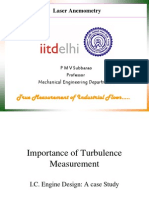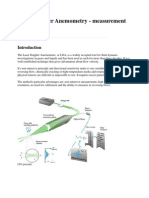0 ratings0% found this document useful (0 votes)
216 viewsLaser Doppler Vibrometer
Laser Doppler Vibrometer
Uploaded by
asdrmpA laser Doppler vibrometer is a non-contact instrument used to measure surface vibration. It works by directing a laser beam at a target surface and analyzing the Doppler shift in the reflected beam caused by the surface's motion. This shift indicates the target's velocity, which can be extracted as an analog voltage output. Laser vibrometers have advantages over contact sensors as they can measure inaccessible, small, or hot targets without affecting their vibration.
Copyright:
© All Rights Reserved
Available Formats
Download as DOC, PDF, TXT or read online from Scribd
Laser Doppler Vibrometer
Laser Doppler Vibrometer
Uploaded by
asdrmp0 ratings0% found this document useful (0 votes)
216 views3 pagesA laser Doppler vibrometer is a non-contact instrument used to measure surface vibration. It works by directing a laser beam at a target surface and analyzing the Doppler shift in the reflected beam caused by the surface's motion. This shift indicates the target's velocity, which can be extracted as an analog voltage output. Laser vibrometers have advantages over contact sensors as they can measure inaccessible, small, or hot targets without affecting their vibration.
Original Description:
Vibrometri
Copyright
© © All Rights Reserved
Available Formats
DOC, PDF, TXT or read online from Scribd
Share this document
Did you find this document useful?
Is this content inappropriate?
A laser Doppler vibrometer is a non-contact instrument used to measure surface vibration. It works by directing a laser beam at a target surface and analyzing the Doppler shift in the reflected beam caused by the surface's motion. This shift indicates the target's velocity, which can be extracted as an analog voltage output. Laser vibrometers have advantages over contact sensors as they can measure inaccessible, small, or hot targets without affecting their vibration.
Copyright:
© All Rights Reserved
Available Formats
Download as DOC, PDF, TXT or read online from Scribd
Download as doc, pdf, or txt
0 ratings0% found this document useful (0 votes)
216 views3 pagesLaser Doppler Vibrometer
Laser Doppler Vibrometer
Uploaded by
asdrmpA laser Doppler vibrometer is a non-contact instrument used to measure surface vibration. It works by directing a laser beam at a target surface and analyzing the Doppler shift in the reflected beam caused by the surface's motion. This shift indicates the target's velocity, which can be extracted as an analog voltage output. Laser vibrometers have advantages over contact sensors as they can measure inaccessible, small, or hot targets without affecting their vibration.
Copyright:
© All Rights Reserved
Available Formats
Download as DOC, PDF, TXT or read online from Scribd
Download as doc, pdf, or txt
You are on page 1of 3
Laser Doppler vibrometer
Basic components of a laser Doppler vibrometer
A laser Doppler vibrometer (LDV) is a scientific instrument that is used to make non-
contact vibration measurements of a surface. The laser beam from the LDV is directed at the
surface of interest, and the vibration amplitude and frequency are etracted from the Doppler
shift of the reflected laser beam frequency due to the motion of the surface. The output of an
LDV is !enerally a continuous analo! volta!e that is directly proportional to the tar!et
velocity component alon! the direction of the laser beam.
"ome advanta!es of an LDV over similar measurement devices such as an accelerometer are
that the LDV can be directed at tar!ets that are difficult to access, or that may be too small or
too hot to attach a physical transducer. Also, the LDV makes the vibration measurement
#ithout mass-loadin! the tar!et, #hich is especially important for $%$" devices.
Principles of operation
A vibrometer is !enerally a t#o beam laser interferometer that measures the frequency &or
phase' difference bet#een an internal reference beam and a test beam. The most common type
of laser in an LDV is the helium-neon laser, althou!h laser diodes, fiber lasers, and (d)*A+
lasers are also used. The test beam is directed to the tar!et, and scattered li!ht from the tar!et
is collected and interfered #ith the reference beam on a photodetector, typically a photodiode.
$ost commercial vibrometers #ork in a heterodyne re!ime by addin! a kno#n frequency
shift &typically ,-./- $01' to one of the beams. This frequency shift is usually !enerated by
a Bra!! cell, or acousto-optic modulator.
A schematic of a typical laser vibrometer is sho#n above. The beam from the laser, #hich has
a frequency f
o
, is divided into a reference beam and a test beam #ith a beamsplitter. The test
beam then passes throu!h the Bra!! cell, #hich adds a frequency shift f
b
. This frequency
shifted beam then is directed to the tar!et. The motion of the tar!et adds a Doppler shift to the
beam !iven by f
d
2 34v&t'4cos&5'67, #here v&t' is the velocity of the tar!et as a function of
time, 5 is the an!le bet#een the laser beam and the velocity vector, and 7 is the #avelen!th of
the li!ht.
Li!ht scatters from the tar!et in all directions, but some portion of the li!ht is collected by the
LDV and reflected by the beamsplitter to the photodetector. This li!ht has a frequency equal
to f
o
8 f
b
8 f
d
. This scattered li!ht is combined #ith the reference beam at the photo-detector.
The initial frequency of the laser is very hi!h &9 :-
:/
01', #hich is hi!her than the response of
the detector. The detector does respond, ho#ever, to the beat frequency bet#een the t#o
beams, #hich is at f
b
8 f
d
&typically in the tens of $01 ran!e'.
The output of the photodetector is a standard frequency modulated &;$' si!nal, #ith the
Bra!! cell frequency as the carrier frequency, and the Doppler shift as the modulation
frequency. This si!nal can be demodulated to derive the velocity vs. time of the vibratin!
tar!et.
Applications
LDVs are used in a #ide variety of scientific, industrial, and medical applications. "ome
eamples are provided belo#)
Aerospace . LDVs are bein! used as tools in non-destructive inspection of aircraft
components.
<:=
Acoustic . LDVs are standard tools for speaker desi!n, and have also been used to
dia!nose the performance of musical instruments.
<3=
Architectural . LDVs are bein! used for brid!e and structure vibration tests.
<,=
Automotive . LDVs have been used etensively in many automotive applications,
such as structural dynamics, brake dia!nostics, and quantification of (oise, vibration,
and harshness &(V0', measurement of accurate speed.
</=
Biolo!ical . LDVs have been used for diverse applications such as eardrum
dia!nostics
<>=
and insect communication.
<?=
@alibration . "ince LDVs measure motion that can be calibrated directly to the
#avelen!th of li!ht, they are frequently used to calibrate other types of transducers.
<A=
0ard Disk Drive Dia!nostics . LDVs have been used etensively in the analysis of
hard disk drives, specifically in the area of head positionin!.
<B=
Landmine detection . LDVs have sho#n !reat promise in the detection of buried
landmines. The technique uses an audio source such as a loudspeaker to ecite the
!round, causin! the !round to vibrate a very small amount #ith the LDV used to
measure the amplitude of the !round vibrations. Areas above a buried mine sho# an
enhanced !round velocity at the resonance frequency of the mine-soil system. $ine
detection #ith sin!le-beam scannin! LDVs,
<C=
an array of LDVs,
<:-=
and multi-beam
LDVs
<::=
has been demonstrated.
"ecurity . Laser Doppler vibrometers &LDVs' as non-contact vibration sensors have
an ability of remote voice acquisition. Dith the assistance of a visual sensor &camera',
various tar!ets in the environment, #here an audio event takes place, can be selected
as reflectin! surfaces for collectin! acoustic si!nals by an LDV. The performance of
the LDV !reatly depends on the vibration characteristics of the selected tar!ets
&surfaces' in the scene, on #hich a laser beam strikes and from #hich it returns.
<:3=
Types of laser Doppler vibrometers
"in!le-point vibrometers . This is the most common type of LDV.
<:,=
Et can measure
one directional out of plane movement.
<:/=
"cannin! vibrometers . A scannin! LDV adds a set of F-* scannin! mirrors, allo#in!
the sin!le laser beam to be moved across the surface of interest.
,-D vibrometers . A standard LDV measures the velocity of the tar!et alon! the
direction of the laser beam. To measure all three components of the tar!etGs velocity, a
,-D vibrometer measures a location #ith three independent beams, #hich strike the
tar!et from three different directions. This allo#s a determination of the complete in-
plane and out-of-plane velocity of the tar!et.
<:>=
Hotational vibrometers . A rotational LDV is used to measure rotational or an!ular
velocity.
Differential vibrometers . A differential LDV measures the out-of-plane velocity
difference bet#een t#o locations on the tar!et.
$ulti-beam vibrometers . A multi-beam LDV measures the tar!et velocity at several
locations simultaneously.
"elf-miin! vibrometers . "imple LDV confi!uration #ith ultra-compact optical head.
These are !enerally based on a laser diode #ith a built-in photodetector.
<:?=<:A=
@ontinuous "can Laser Doppler Vibrometry &@"LDV' . A modified LDV that s#eeps
the laser continuously across the surface of the test specimen to capture the motion of
a surface at many points simultaneously
You might also like
- AT&TDocument2 pagesAT&TSteffani GuzmánNo ratings yet
- In Nomine - Infernal Players GuideDocument131 pagesIn Nomine - Infernal Players Guidemoonrune86% (7)
- Star Wars Insider 207 (January 2022)Document84 pagesStar Wars Insider 207 (January 2022)Mario MajoniNo ratings yet
- Laser Doppler Vibrometry and Modal TestingDocument17 pagesLaser Doppler Vibrometry and Modal TestingNanda KurniaNo ratings yet
- Radio Propagation and Antennas: A Non-Mathematical Treatment of Radio and AntennasFrom EverandRadio Propagation and Antennas: A Non-Mathematical Treatment of Radio and AntennasRating: 5 out of 5 stars5/5 (1)
- Laser VibrometerDocument22 pagesLaser VibrometerWisss FisssNo ratings yet
- Laser Doppler VelocimetryDocument20 pagesLaser Doppler Velocimetryimsandy09No ratings yet
- RADAR Notes PDFDocument115 pagesRADAR Notes PDFVamshi Krishna100% (2)
- Laser Dopler LiteraDocument10 pagesLaser Dopler LiteraSetyawan ApsNo ratings yet
- Laser Doppler Anemometry: (Measuring Flow Velocity in A Highly Sophisticated Way)Document14 pagesLaser Doppler Anemometry: (Measuring Flow Velocity in A Highly Sophisticated Way)anon_287164994No ratings yet
- Unit 4Document28 pagesUnit 4raviNo ratings yet
- True Measurement of Industrial Flows ..: Laser AnemometryDocument29 pagesTrue Measurement of Industrial Flows ..: Laser AnemometryRahul TripathiNo ratings yet
- Denisowski - Comparison of Radio Direction-Finding TechnologiesDocument29 pagesDenisowski - Comparison of Radio Direction-Finding TechnologiesVivek GopalNo ratings yet
- Modes Ultrasound UpdateDocument81 pagesModes Ultrasound UpdateMondiaal Financial ServicesNo ratings yet
- Delay Line CancelerDocument41 pagesDelay Line Cancelergzb012No ratings yet
- Radar and Navigational AidsDocument44 pagesRadar and Navigational AidsRajesh Natarajan100% (1)
- Electromagnetic Flow Rate SensorDocument37 pagesElectromagnetic Flow Rate Sensorsnigdha.chaturvediNo ratings yet
- The Laser Torsional Vibrometer: A Step Forward in Rotating Machinery DiagnosticsDocument20 pagesThe Laser Torsional Vibrometer: A Step Forward in Rotating Machinery DiagnosticsNini CortesNo ratings yet
- Doppler Echocardiography-1: Basic Physics, Pulse Wave and Continuos Wave DopplerDocument141 pagesDoppler Echocardiography-1: Basic Physics, Pulse Wave and Continuos Wave DopplerMaria EdelNo ratings yet
- Lecture No. 6 Doppler Lecture 10 - TaggedDocument51 pagesLecture No. 6 Doppler Lecture 10 - TaggedMohammed Khalil SaeedNo ratings yet
- Topic 4 Radar FundamentalsDocument127 pagesTopic 4 Radar FundamentalsMuhammad Haziq afnan Bin Mohd SarNo ratings yet
- BEWK Notes Sem5Document80 pagesBEWK Notes Sem5Midhul Mineesh100% (1)
- Intro To UltrasonicsDocument21 pagesIntro To UltrasonicsVaraGoudNo ratings yet
- Laser Flowmeters: Presented By: Harish Kumar TomarDocument14 pagesLaser Flowmeters: Presented By: Harish Kumar Tomarreddi ramuNo ratings yet
- Mechanical Waves Doppler Effect and Its Application in MedicineDocument15 pagesMechanical Waves Doppler Effect and Its Application in MedicineMohammod Saimon NehaliNo ratings yet
- Laser Doppler Anemometry: Introduction To Principles and ApplicationsDocument25 pagesLaser Doppler Anemometry: Introduction To Principles and ApplicationsAdyant AgrawalNo ratings yet
- 23 2 ET V1 S1 - Radar Basics PDFDocument74 pages23 2 ET V1 S1 - Radar Basics PDFShailendra SinghNo ratings yet
- Laser Doppler AnemometryDocument6 pagesLaser Doppler AnemometrylokeshmopuriNo ratings yet
- FM Radar - 2014Document36 pagesFM Radar - 2014Guang ChenNo ratings yet
- Color and Power DopplerDocument114 pagesColor and Power DopplerThuraiya Al MasoudiNo ratings yet
- Basic Radar Principles: Radio Waves Would Reflect From MetalDocument54 pagesBasic Radar Principles: Radio Waves Would Reflect From MetalMahami M ProsperNo ratings yet
- Radar EngineeringDocument13 pagesRadar Engineeringismart ShankarNo ratings yet
- 8.2ultra Sonic-Testing-Part 2Document24 pages8.2ultra Sonic-Testing-Part 2Mohanad AlmalahNo ratings yet
- Radar: Department of Electronics and TelecommunicationDocument25 pagesRadar: Department of Electronics and TelecommunicationsaralNo ratings yet
- Unit-5 RADARs PptsDocument146 pagesUnit-5 RADARs PptsRam KalvaNo ratings yet
- Term Paper TopicsDocument15 pagesTerm Paper TopicsAamir Imam KhanNo ratings yet
- Doppler EffectDocument45 pagesDoppler EffectWaleed J sKNo ratings yet
- Metrology of Optical Components. Interferometry. DMDocument48 pagesMetrology of Optical Components. Interferometry. DMaugusteNo ratings yet
- CW and Frequency Modulated RadarDocument30 pagesCW and Frequency Modulated RadarbeslinNo ratings yet
- RADAR Lec1 (Introduction)Document24 pagesRADAR Lec1 (Introduction)ABDULLAH MD. ZOBAYER 1602090No ratings yet
- What Is The Principle of Ultrasonic Level Measurement?Document5 pagesWhat Is The Principle of Ultrasonic Level Measurement?Hamed RazaNo ratings yet
- L E #4 T D E, B S S I - I: Aboratory Xercise HE Oppler Ffect Eats and The Peed of Ound N T R O D U C T I O NDocument3 pagesL E #4 T D E, B S S I - I: Aboratory Xercise HE Oppler Ffect Eats and The Peed of Ound N T R O D U C T I O NJulien SiinoNo ratings yet
- Advancements in Tools Used While LoggingDocument38 pagesAdvancements in Tools Used While LoggingSudeep Chandra VarmaNo ratings yet
- UtDocument48 pagesUtstanleyNo ratings yet
- Electronic NavigationDocument39 pagesElectronic NavigationHans Marc SimplicioNo ratings yet
- Basic Principles of Ultrasonic Testing PDFDocument73 pagesBasic Principles of Ultrasonic Testing PDFSisira Chandrasoma100% (1)
- Unit-4 Tracking RadarDocument58 pagesUnit-4 Tracking RadarMani Prince100% (1)
- Wave Propogation EffectDocument4 pagesWave Propogation EffectPrashanth ChikkannanavarNo ratings yet
- ANDT Module 4Document67 pagesANDT Module 4aswinkrishnakjkd02No ratings yet
- 1 s2.0 S0143816616303724 MainDocument12 pages1 s2.0 S0143816616303724 MainNorman ZhuNo ratings yet
- Doppler Ultrasound PhysicsDocument28 pagesDoppler Ultrasound PhysicsMarina MonulNo ratings yet
- Vertical Seismic Profiling VSPDocument29 pagesVertical Seismic Profiling VSPAndres Guillermo TovarNo ratings yet
- Doppler Echocardiography: Dr.S.R.Sruthi Meenaxshi MBBS, MD, PDFDocument38 pagesDoppler Echocardiography: Dr.S.R.Sruthi Meenaxshi MBBS, MD, PDFsruthimeena6891No ratings yet
- Radar Range Measurement: Ran GeDocument16 pagesRadar Range Measurement: Ran Gevishnuu06No ratings yet
- LogsDocument46 pagesLogsGopu ThalikunnathNo ratings yet
- Laser DoplerDocument5 pagesLaser DoplerArunNo ratings yet
- Experiments in Fluids Millerd, 1996Document8 pagesExperiments in Fluids Millerd, 1996Kalpana BaareNo ratings yet
- Basic Principles of Ultrasonic TestingDocument73 pagesBasic Principles of Ultrasonic TestingDeepulal LalanNo ratings yet
- Modes o EchoDocument15 pagesModes o EchoSoad ShedeedNo ratings yet
- Radio Control for Model Ships, Boats and AircraftFrom EverandRadio Control for Model Ships, Boats and AircraftRating: 5 out of 5 stars5/5 (1)
- Cruiise ControlDocument10 pagesCruiise Controlkiovas33No ratings yet
- Case Study-MoriyamaDocument2 pagesCase Study-MoriyamaCheyTac SojuNo ratings yet
- (Estonian Pronunciation: ( Ɑrvo Pært)Document5 pages(Estonian Pronunciation: ( Ɑrvo Pært)api-483417422No ratings yet
- ARPDocument2 pagesARPKamran ShahidNo ratings yet
- Dokumen - Tips Kyu Belt Karate Student Goju Ryu Karate Do Is The Primary Style Offered at ToraguchiDocument53 pagesDokumen - Tips Kyu Belt Karate Student Goju Ryu Karate Do Is The Primary Style Offered at ToraguchiSabry MartelNo ratings yet
- Buzz Flight Host GuidelineDocument7 pagesBuzz Flight Host Guidelinebuzzrproblox13No ratings yet
- BX1S-KV-BT212M80 P40 P52 P52 LP52N BT212M81 BT212N40 BT212N50Document11 pagesBX1S-KV-BT212M80 P40 P52 P52 LP52N BT212M81 BT212N40 BT212N50Jomasando10No ratings yet
- Basic Sewing Steps Basic Sewing Steps Basic Sewing Steps Basic Sewing StepsDocument23 pagesBasic Sewing Steps Basic Sewing Steps Basic Sewing Steps Basic Sewing StepsGrama100% (1)
- Stylos HD User GuideDocument199 pagesStylos HD User GuideJohn K SmithNo ratings yet
- Big House Blues Reanimated InfoDocument10 pagesBig House Blues Reanimated Infochristian TalaricoNo ratings yet
- Door Steering ControllerDocument4 pagesDoor Steering Controllerumair409No ratings yet
- Why Is Water Important in Life? WhatDocument4 pagesWhy Is Water Important in Life? Whataro0j100% (1)
- PeturaboDocument1 pagePeturaboGrant Kelly100% (1)
- Manual Cyon - Eng PDFDocument64 pagesManual Cyon - Eng PDFmarioNo ratings yet
- Simon vs. Homo Sappiens Agenda Book ReportDocument8 pagesSimon vs. Homo Sappiens Agenda Book ReportAlmira Alingcastre GatusNo ratings yet
- Bolt RPG (Lock-In Copy)Document112 pagesBolt RPG (Lock-In Copy)Marcos InkiNo ratings yet
- University of The Philippines Madrigal SingersDocument4 pagesUniversity of The Philippines Madrigal SingersJason TiongcoNo ratings yet
- MimioPro OPS SpecsheetDocument3 pagesMimioPro OPS SpecsheetJHONY MARTINEZNo ratings yet
- Romeo and Juliet CrosswordDocument2 pagesRomeo and Juliet CrosswordkcNo ratings yet
- CAIE - VIII - ICT - File ManagementDocument20 pagesCAIE - VIII - ICT - File ManagementInvincible Nasir The ProNo ratings yet
- GR 3 RCDocument1 pageGR 3 RCDarleina KellnNo ratings yet
- Dark Side of The Moon (Album)Document10 pagesDark Side of The Moon (Album)Cássio D'LimaNo ratings yet
- Pampered Chef Contempory Stoneware Classic RecipesDocument19 pagesPampered Chef Contempory Stoneware Classic RecipesKate Prolman100% (1)
- Teaching and Performing Poetry - 20060225seed NetworkDocument86 pagesTeaching and Performing Poetry - 20060225seed NetworkDinesh CidocNo ratings yet
- KSI Rules - Final Revision in Effect For WT 2018Document53 pagesKSI Rules - Final Revision in Effect For WT 2018Sophia StamatiadisNo ratings yet
- ManzanaresMartinez AngelKaleb M07S1AI2Document3 pagesManzanaresMartinez AngelKaleb M07S1AI2Saul MartinezNo ratings yet
- Network DevicesDocument38 pagesNetwork DevicesNoel DaefNo ratings yet

























































































